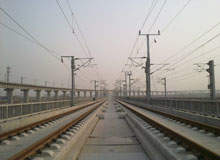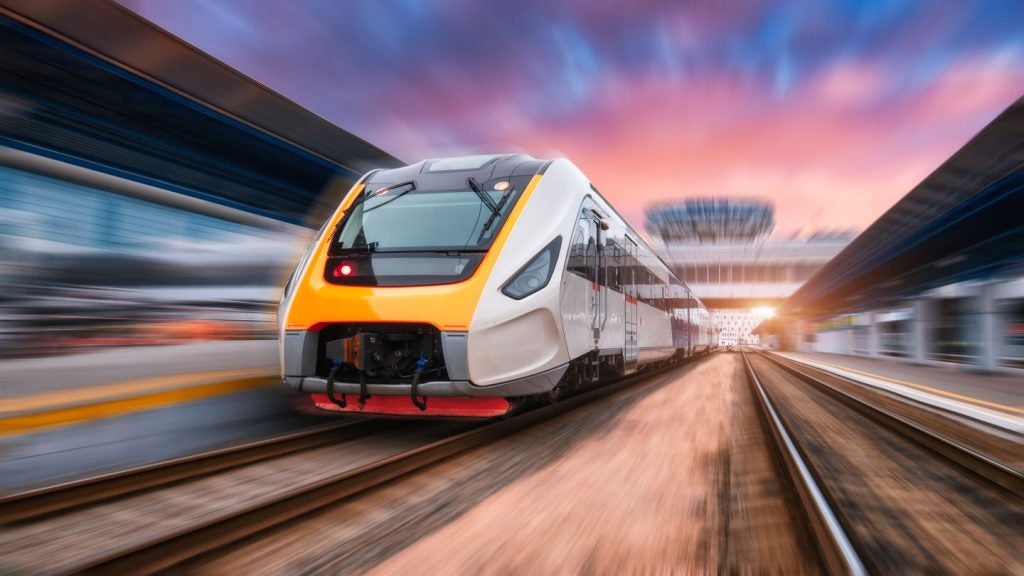
Six of the ten longest high-speed railway (HSR) lines in the world are located in China, while the remaining four are in Spain, Japan, Russia and the UK. Railway-technology.com profiles the longest high-speed lines in the world based on their operational length as of 2013.
Beijing-Guangzhou High-Speed Line, China
China’s Beijing-Guangzhou high-speed line, which opened in December 2012, is currently the world’s longest high-speed railway line with a total length of 2,298km. The line, also known as Jingguang HSR, has reduced the travel time between Beijing and Guangzhou to just eight hours, compared with the previous 22-hour journey.
The HSR line is operated with CRH380-AL trains designed for a maximum speed of 350kmph and comprises four sections: Beijing-Shijiazhuang-Zhengzhou (693km), Zhengzhou-Wuhan (536km), Wuhan-Guangzhou (968km) and Guangzhou-Shenzhen (102km).
The high-speed line traverses Hebei, Henan, Hubei, Hunan and Guangdong provinces, connecting 28 major Chinese cities and 35 stations along the route. It also provides interconnections to other high-speed lines including the Shijiazhuang-Taiyuan HSR, Zhengzhou-Xi’an HSR, Shanghai-Wuhan-Chengdu HSR and the Guangzhou-Zhuhai HSR.
Shanghai-Wuhan-Chengdu High-Speed Line, China
The Shanghai-Wuhan-Chengdu high-speed line, or Huhanrong HSR, in China is currently the world’s second longest high-speed line. By the end of 2013 the operational length of this major east-west high-speed rail corridor in China was 1,814km. Construction of the remaining 264km Chongqing-Lichuan section is expected to finish in 2014.
The HSR will pass through four provinces and two municipalities, connecting the cities of Shanghai, Nanjing, Hefei, Wuhan, Chongqing and Chengdu when fully commissioned. The line comprises seven sections including the 301km Shanghai-Nanjing section which shares the line with Beijing-Shanghai HSR.
How well do you really know your competitors?
Access the most comprehensive Company Profiles on the market, powered by GlobalData. Save hours of research. Gain competitive edge.

Thank you!
Your download email will arrive shortly
Not ready to buy yet? Download a free sample
We are confident about the unique quality of our Company Profiles. However, we want you to make the most beneficial decision for your business, so we offer a free sample that you can download by submitting the below form
By GlobalDataThe operational speed of trains running on the Huhanrong HSR varies between 200kmph and 250kmph; the Shanghai-Nanjing section, however, is designed for speeds up to 350kmph. The high-speed line, designed for both mixed passenger and freight services, is expected to reduce travel time between Shanghai and Chongqing to ten hours, compared with the 27 hours currently taken on conventional rail.
Beijing-Shanghai High-Speed Line, China
The 1,318km long Beijing-Shanghai high-speed line, also known as Jinghu HSR, is the third longest high-speed railway line in the world and the longest high-speed railway line to be constructed in a single phase. Construction commenced in 2008 and the line was commissioned in 2011.
The high-speed line passes through the Hebei, Shandong, Anhui and Jiangsu provinces of China and includes 24 stations along the route connecting major cities such as Beijing, Shanghai and Tianjin. The HSR also provides interconnections to other high-speed lines such as the Beijing-Harbin HSR, Qingdao-Taiyuan HSR, Xuzhou-Lanzhou HSR and Shanghai-Wuhan-Chengdu HSR. The HSR also connects Hefei with the 131km Bengbu-Hefei high-speed line.
The Jinghu HSR is operated with more than 90 CRH trains and has reduced the journey time between Beijing and Shanghai to 4.48 hours. The total investment on the high-speed railway project has reached RMB220bn ($36.108m).
Hangzhou-Fuzhou-Shenzhen High-Speed Line, China
China’s Hangzhou-Fuzhou-Shenzhen high-speed line, also known as the Hangfushen HSR, has an operational route length of 993km and is the world’s fourth longest high-speed railway line. It will eventually link the Yangtze River Delta on the East China Sea and Pearl River Delta on the South China Sea when the entire route is operational.
The Hangfushen HSR is a dual-track, electrified, high-speed rail line being developed along the south-eastern coast of China. The line, forming part of the larger Southeast Coast HSR Corridor, passes through three coastal provinces – Zhejiang, Fujian and Guangdong. The operational speed of the Hangfushen HSR varies between 250kmph and 350kmph.
The four operating sections of the line include the 152km Hangzhou-Ningbo section, the 268km Ningbo-Taizhou-Wenzhou section, the 298km Wenzhou-Fuzhou section and the 275km Fuzhou-Xiamen section. The last and longest section of the HSR, the 502km long Xiamen-Shenzhen high-speed line, is scheduled for commissioning in 2014.
Beijing-Harbin High-Speed Line, China
The Beijing-Harbin high-speed line, or Jingha HSR, the main high-speed corridor in north-east China, also has an operating route length of 993km, tying it for the fourth longest high-speed railway line in the world. It will, however, eventually surpass the Hangzhou-Fuzhou-Shenzhen high-speed line in length when the 684km Beijing-Shenyang section is commissioned in 2014.
The completed sections of the Beijing-Harbin HSR line include the 904km Harbin-Dalian line and the 89km Panjin-Yingkou line. The HSR will for the most part run parallel to the existing conventional Beijing-Harbin rail line. The new line will cut the travel time between Beijing and Harbin by about four hours compared with the nine hours currently taken on conventional rail.
The HSR is designed to reach speeds of up to 350kmph; normal operating speeds however are 300km/h, which is reduced to 200km/h during the winter season. The lines are specially designed to cope with extreme temperatures varying from below -40°C in winter to above 40°C in summer.
Madrid-Barcelona-French Border High-Speed Line, Spain
Spain’s Madrid-Barcelona-French Border high-speed line, which runs for a total of 804km, is the world’s fifth longest high-speed line. The line was constructed in five stages and became fully operational in January 2013.
The 442km Madrid-Lleida section was opened in October 2003, the 78km Lleida-Tarragona section in December 2006, the 100km Tarragona-Barcelona section February 2008, the 44.4km Perpignan-Figueres in December 2010, and the 150km Barcelona and Figueres (French Border) section in January 2013.
Alta Velocidad Española (AVE) trains, which reach speeds of 350kmph on 86% of the route, are operated by RENFE. The journey time from Madrid and Barcelona through the high-speed line is 2.38 hours.
Tohoku Shinkansen High-Speed Line, Japan
The Tohoku Shinkansen high-speed line, which forms part of the network of high-speed Shinkansen train lines in Japan, is the sixth longest high-speed railway line in the world. The 675.92km long Tohoku Shinkansen high-speed line was constructed between 1971 and 1982 and runs between the capital city Tokyo and Shin-Aomori.
The line is currently serviced by E2, E3, E5, and E6 Series Shinkansen high-speed trains, with an operating speed of 320kmph. A Maglev train reached a world record maximum speed of 581kmph on the Tohoku Shinkansen HSR line in 2003.
More than 1.93 billion passengers used the high-speed railway line as of June 2012. East Japan Railway Company (JR East) is currently extending the line to convert certain sections to dual gauge by March 2016.
Moscow-St Petersburg High-Speed Line, Russia
The Moscow-St Petersburg high-speed line, with a length of about 650km, is the seventh longest high-speed railway line in the world. The Russian railway line was originally opened in 1851 and upgraded for high-speed rail operation in 2009.
The line is operated by Oktyabrskaya Railway, a subsidiary of Russian Railways, and served by Siemens Velaro RUS (Sapsan) trains and the RVR-built ER200 electric trains. It has reduced the journey time from Moscow to St Petersburg to three and a half hours running at an operating speed of 250kmph.
The line passes through Moscow, Tver, Novgorod and Leningrad Oblasts, and includes main stations at Klin, Redkino, Tver, Likhoslavl, Kalashnikovo, Vyshny Volochyok, Bologoye, Okulovka, Luka, Malaya Vishera, Chudovo, Lyuban and Tosno. A parallel high-speed line with a length of 660km has been planned along the route to provide trains running at a top speed of 400kmph.
West Coast Main Line, United Kingdom
The West Coast Main Line (WCML), also known as the Premier Line, in the UK is currently the eighth longest high-speed line in the world. The 645.35km line, owned and operated by Network Rail, extends from London to Glasgow and provides key divergences to Birmingham, Liverpool and Manchester.
The line was originally opened in 1849 and witnessed a £8.8bn ($14.3bn) upgrade called the West Coast Route Modernisation (WCRM) programme in 2008, enabling high-speed operation at a maximum speed of 225kmph.
The rolling stock operated on the line includes 53 Class 390 Pendolino fixed-formation electric tilting trains operated by Virgin Trains. WCML is currently the busiest mixed-use railway in the UK. It is used by multiple operators and accounts for 43% of Britain’s freight traffic.
Xiangtang-Putian Railway, China
The Xiangtang-Putian high-speed line in China, also known as the Xiangpu HSR, is the ninth longest high-speed line in the world. Construction on the high-speed line, which measures about 632km, began in 2008 and the line was opened in September 2012. The operating speed of trains on the line is 250kmph.
The line stretches from Xiangtang Nanchang, the capital city of Jiangxi province, to Putian and Fuzhou in Fujian province. It has reduced travel time from Nanchang to Fuzhou to 3.5 hours from the original 11 hours. The route includes 22 stations, and runs through seven districts and counties in the two provinces.
The HSR provides both passenger and freight services, and uses ten CRH2A EMUs supplied by CSR Qingdao Sifang and five CRH1 EMUs supplied by Bombardier Sifang.





